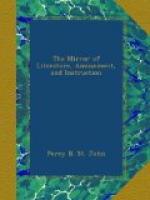Elephants.
All the elephants which were exported from Point de Galle were caught in ancient, as well as in modern times, in that tract of country which extends from Matura to Tangcolle, in the south of Ceylon, and which, from its being famous for its elephants in his days, is described by Ptolemy in the map he made of Ceylon sixteen hundred years ago as the elephantum pascua. The trade in elephants from Ceylon, which used to be lucrative, is now completely annihilated, in consequence of all the petty Rajahs, Foligars, and other chiefs in the southern peninsula of India, who used formerly to purchase Ceylon elephants as a part of their state, having lost their sovereignties, and being therefore no longer required to keep up any state of this description. A gentleman who has a plantation at Candy, it is understood, recently introduced the use of elephants, in ploughing, with great advantage.—Trans. Asiatic Society.
* * * * *
The Fennecous Cerdo.
[Illustration: Fennecous Cerdo.]
This beautiful and extraordinary animal, or at least one of its genus, was first made known to European naturalists by Bruce, who received it from his dragoman, whilst consul general at Algiers. It is frequently met with in the date territories of Africa, where the animals are hunted for their skins, which are afterwards sold at Mecca, and then exported to India. Bruce kept his animal alive for several months, and took a drawing of it in water colours, of the natural size, a copy of which, on transparent paper, was clandestinely made by his servant. Mr. Brander, into whose hands the Fennecus fell after Bruce left Algiers, gave an account of it in “Some Swedish Transactions,” but refused to let the figure be published, the drawing having been unfairly obtained.[3] Bruce asserts that this animal is described in many Arabian books, under the name of El Fennec, which appellation he conceives to be derived from the Greek word for a palm or date-tree.
The favourite food of Bruce’s Fennec was dates or any sweet fruit; but it was also very fond of eggs; when hungry it would eat bread, especially with honey or sugar. His attention was immediately attracted if a bird flew near him, and he would watch it with an eagerness that could hardly be diverted from its object; but he was dreadfully afraid of a cat. Bruce never heard that he had any voice. During the day he was inclined to sleep, but became restless and exceedingly unquiet as night came on. The above Fennec was about ten inches long, the tail five inches and a quarter, near an inch of it on the tip, black. The colour of the body was dirty white, bordering on cream colour; the hair on the belly rather whiter, softer and longer than on the rest of the body. His look was sly and wily; he built his nest on trees, and did not burrow in the earth.




